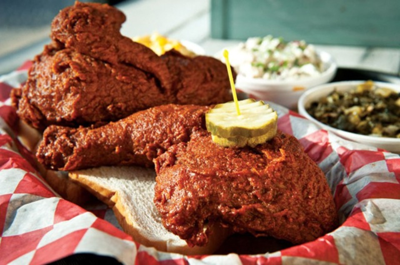
George Embiricos at Food Republic has written a hot mess of an article on Hattie B’s hot chicken that gives credit for the popularity of the dish to the white guys who took a piece of black culinary culture and made it cool. This is not me paraphrasing. This is literally what Embiricos says:
Today, Hattie B’s has two Nashville locations, in addition to one in Birmingham, Alabama, with plans to expand throughout the Southeast. Lengthy lines — packed with locals, tourists and celebrities alike — regularly stretch down the block during peak times. Prince’s Hot Chicken Shack may have created hot chicken in the 1930s, and institutions like Bolton’s Spicy Chicken & Fish may have helped preserve the tradition over the years, but Hattie B’s has made hot chicken cool.
Before Hattie B’s opened, there was plenty of hot chicken in Nashville, but the emphasis was always on the “hot” part. Lasater put more focus on the chicken, using high-quality birds. That, combined with a central location, an outdoor patio, pairing the chicken with sweet options like waffles and offering local beers on tap, changed the hot-chicken experience. All have proved vital to Hattie B’s sustained success, cementing its place among the city’s staples.
Let me remind you, it’s 2016. We’ve lived through white people “inventing” rock & roll so they could sell it to white people and then half a century of people — black and white — pointing out that it’s an older art form than that. We’ve lived through a century of “vulgar” “exotic” “indecent” dances done by black kids becoming “fun” and “energetic” and “cool” when white kids do it — see everything from the hop straight through breakdancing through whatever kids are doing today. Graffiti, when black kids were doing it, was criminal and fed into gang culture. Banksy does it and now it’s worth preserving and spending money to collect it. There’s not a black art form, food included, that by this point hasn’t been popularized by white people and then the popularized version celebrated by white media like white people invented it, or at least, perfected it.
If, at this point, you’re still writing articles where black people have been doing shit for years, going mostly unnoticed by white people, and it’s only when the white people come in and decide to monetize it that you declare it cool, then you are the problem with America.
Let me be clear. Hattie B’s did make some important innovations to the hot chicken game in Nashville — they located themselves where a lot of people could easily find them; they take credit cards; they have a kid’s menu; and they serve beer. But once you’re talking about how Hattie B’s is doing something special because they care about “umami” — insinuating that other places don’t and thus are lacking something that would make them appealing to true foodies — your head is up your own ass.
There’s an interesting and important story still to be written about the racial politics surrounding hot chicken, like what it means for a city that prides itself on being forward-thinking on race and that celebrates a dish we all proudly acknowledge has a long black history, but which most of us did not embrace until Mayor Bill Purcell made it okay (which is the other thing annoying about Embiricos’s article: He doesn’t even give the right white guy credit for clearing the way for white people to eat hot chicken).
Rachel Martin’s piece over at the Bitter Southerner begins to wrestle with this (and I recommend you read the whole thing):
“What’s hot chicken?” she asked. “Have we been eating our chicken wrong all these years?”
I asked my dad if he had ever had it. “Nope,” he said. But he taught school in the 1970s, and he remembered that some of the black teachers carried their own bottles of hot sauce. Sometimes they’d prank him by spiking his cafeteria lunch.
Was this the answer? Was hot chicken a part of the city’s history that had been invisible to me as a white woman? I asked Denise, an older African-American woman in my church who was raised in the city.
“Of course you didn’t eat hot chicken,” she said, shaking her head at me. “Hot chicken’s what we ate in the neighborhood.
So, let’s be honest. When you have a chicken dish that a quarter of the city has loved for almost a century and the rest of the city comes to love when they learn about it, it’s racism that kept most white people from knowing about hot chicken, because white people didn’t go into black neighborhoods. When the black people who have the decades’ long expertise in making hot chicken don’t grow rich off it, but the white kid who got to go to culinary school does, it’s not because his hot chicken tastes better. It’s that it’s still really hard for black people to go to culinary school or to get the bank loans that would let them expand their businesses into neighborhoods white people will visit.
No one should begrudge Hattie B’s their success. The food’s great. The locations are great. But for George Embiricos and John Lasater to both fail to acknowledge the fundamental reason Hattie B’s is more successful than the older hot chicken joints just feeds into the same old racist dishonesty we love as a country. And that’s a real shame.





